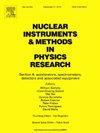Development of electron beam irradiation station for FLASH experiments at the PBP-CMU Electron Linac Laboratory
IF 1.4
3区 物理与天体物理
Q3 INSTRUMENTS & INSTRUMENTATION
Nuclear Instruments & Methods in Physics Research Section A-accelerators Spectrometers Detectors and Associated Equipment
Pub Date : 2025-07-23
DOI:10.1016/j.nima.2025.170875
引用次数: 0
Abstract
FLASH radiotherapy (FLASH-RT) delivers ultra-high dose-rate radiation, enabling effective tumor treatment while minimizing damage to surrounding healthy tissue. Implementing this technique requires precise control of electron beam parameters and dose uniformity. This work presents the development of an electron beam irradiation station at the PBP-CMU Electron Linac Laboratory (PCELL), which was structured in four key stages: conceptual design, simulation-based evaluation, physical implementation, and experimental verification. The conceptual design involved the selection of beamline components, diagnostic layout, and irradiation system architecture. Beam dynamics simulations using the ASTRA and Monte Carlo simulations using GEANT4 were performed to optimize beam transport, evaluate interactions with a titanium window, and assess the effectiveness of aluminum flattening filters in achieving uniform dose distributions. Thermal effects from energy deposition in the flattening filter were also analyzed to guide cooling system design. In the implementation stage, the station was constructed with integrated diagnostics, including a dipole magnet and a Faraday cup for energy measurement and a high-resolution current transformer for charge diagnostics. Systematic errors in beam energy measurement were quantified at 3.3%–3.5%, and the CT achieved a bunch charge resolution of 1–2 pC. The experimental verification included calibration of beam diagnostics, beam alignment, and initial system commissioning. While the system demonstrates high precision and dose uniformity, further work is required to evaluate biological effects in FLASH experiments. Future research will focus on real-time dosimetry integration, biological studies, and system automation to further enhance its capabilities.
PBP-CMU电子直线加速器实验室FLASH实验电子束辐照站的研制
FLASH放射治疗(FLASH- rt)提供超高剂量率的辐射,实现有效的肿瘤治疗,同时最大限度地减少对周围健康组织的损害。实现该技术需要精确控制电子束参数和剂量均匀性。这项工作介绍了PBP-CMU电子直线实验室(PCELL)电子束辐照站的开发,该实验室分为四个关键阶段:概念设计、基于仿真的评估、物理实现和实验验证。概念设计包括光束线组件的选择、诊断布局和辐照系统架构。使用ASTRA进行光束动力学模拟,使用GEANT4进行蒙特卡罗模拟,以优化光束输运,评估与钛窗的相互作用,并评估铝压平滤波器在实现均匀剂量分布方面的有效性。还分析了压平过滤器中能量沉积的热效应,以指导冷却系统的设计。在实施阶段,该站建设了集成诊断,包括用于能量测量的偶极磁铁和法拉第杯,以及用于电荷诊断的高分辨率电流互感器。束流能量测量系统误差为3.3% ~ 3.5%,束荷分辨率为1 ~ 2 pC。实验验证包括波束诊断校准、波束对准和初始系统调试。虽然该系统显示出高精度和剂量均匀性,但需要进一步的工作来评估FLASH实验中的生物效应。未来的研究将集中在实时剂量测量集成、生物学研究和系统自动化方面,以进一步提高其能力。
本文章由计算机程序翻译,如有差异,请以英文原文为准。
求助全文
约1分钟内获得全文
求助全文
来源期刊
CiteScore
3.20
自引率
21.40%
发文量
787
审稿时长
1 months
期刊介绍:
Section A of Nuclear Instruments and Methods in Physics Research publishes papers on design, manufacturing and performance of scientific instruments with an emphasis on large scale facilities. This includes the development of particle accelerators, ion sources, beam transport systems and target arrangements as well as the use of secondary phenomena such as synchrotron radiation and free electron lasers. It also includes all types of instrumentation for the detection and spectrometry of radiations from high energy processes and nuclear decays, as well as instrumentation for experiments at nuclear reactors. Specialized electronics for nuclear and other types of spectrometry as well as computerization of measurements and control systems in this area also find their place in the A section.
Theoretical as well as experimental papers are accepted.

 求助内容:
求助内容: 应助结果提醒方式:
应助结果提醒方式:


